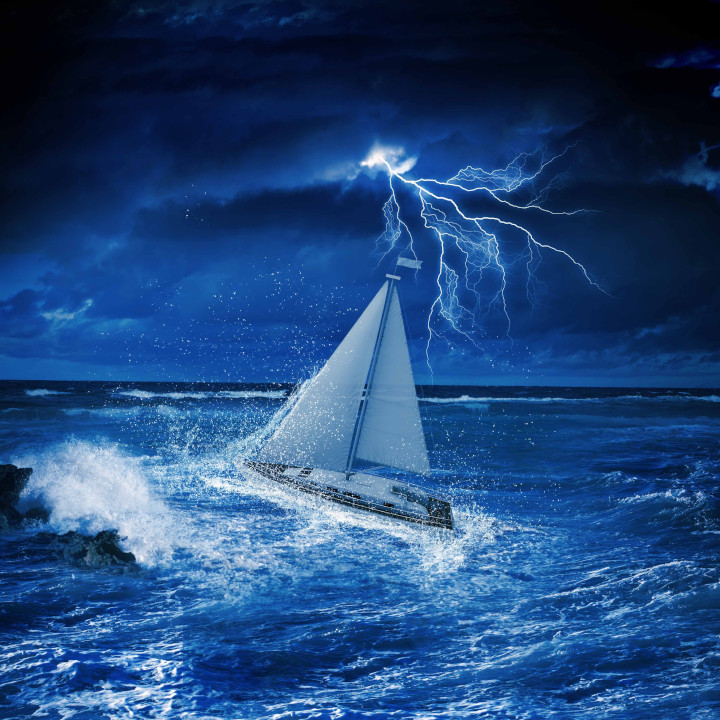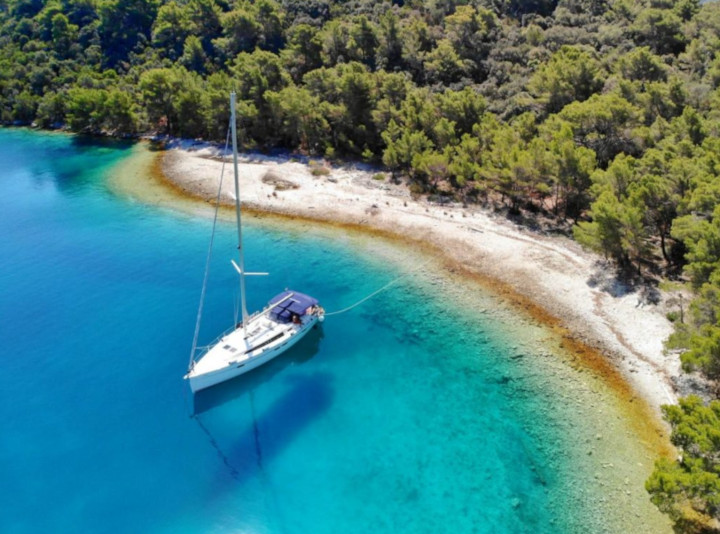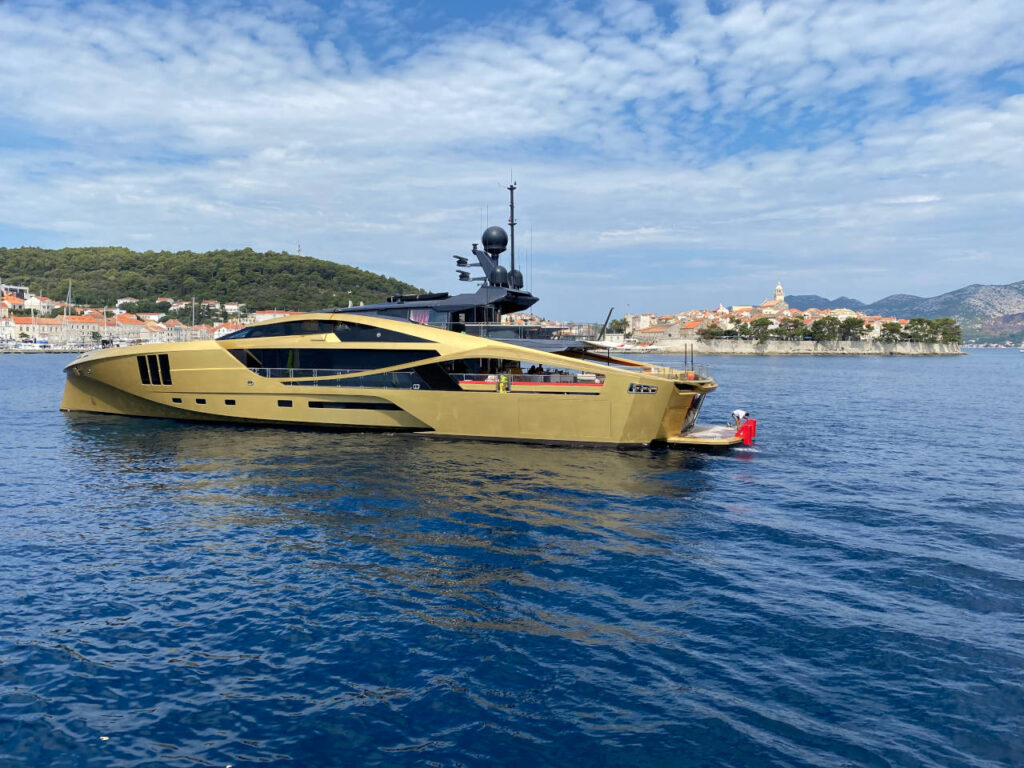How dangerous is sailing?
Before you decide to go sailing you’re definitely going to ask yourself questions like “Is sailing dangerous?” or “How dangerous is sailing?”. It’s a question that everyone will ask themselves because no one wants to get their friends and families in danger. Actually, there’s no short answer to this as it depends on many factors like where do you go for a sail, what’s the level of your knowledge and training, how experienced is your skipper or your crew if you decide to hire them, etc.
According to statistics sailing is one of the safest ways to explore the world. But it doesn’t mean it doesn’t involve any risks coming with it. We’ll first explain what are the risks of sailing and after that, we’ll go with sailing destinations and the problems surrounding them.
What are the dangers of sailing?
There are many dangers of sailing especially if you sail in oceans. Here are some main dangers to be aware of:
- Bad weather with storms and squalls
- Big Waves
- Lightning strikes
- Men falling overboard
- Mast falling off
- Hitting floating objects or whales
- Pirates at some places
- Collisions with other boats
- Sinking
The good thing about this is that most of these dangers are easily avoidable if you watch the weather forecasts, sail in safe waters, check your boat pre-sailing, and be more cautious overall. The operator’s factor is huge in avoiding sailing accidents and dangers.
Is Ocean sailing more dangerous than coastal sailing?
It actually depends on how you take it, so I’ll give my own opinion as a skipper on this one as many skippers probably won’t agree with me. As a skipper, I crossed the Atlantic many times and was sailing in many waters around the globe, and I think that ocean sailing is more dangerous than Coastal sailing, but it depends on where you’re sailing.
Coastal sailing extends up to 2 nautical miles or 3.7 km from the coast and that means there are some dangers there. You can hit rocks, shoals, other boats, wrecks, signalization buoys, etc. and it requires constant attention for you to sail safely. So it can be dangerous to sail near the coast, but the help is almost always there in a matter of minutes. That’s exactly the reason why sailing near the coast simply makes you feel safe.
But no matter how many things I listed as problems while sailing near the coast in my opinion nothing listed can compare to the situation when you encounter bad weather or engine failure in the middle of the ocean. You’re literally surrounded by nothing and there’s no one to help you for a long period of time. You have to be capable of taking care of yourself as there’s no rescue, no mechanic, and you’re left on your own. Looking at the horizon makes you feel even more depressed and I’ve been there. I’ve felt it and it isn’t pleasant so I can say that any problem I encountered in my 20 years of experience of sailing can’t match the frustration of being unable to move in the middle of the Atlantic.
How dangerous is sailing across the Atlantic
When crossing the Atlantic the main danger lies in the fact that you’ll be on an open ocean for two to four weeks depending on how fast you travel. Any kind of help won’t come that fast
While crossing the ocean the equipment and your boat are put under constant pressure so there’s a higher chance you’ll encounter problems. Your boat is working 24 hours a day, non-stop, for a few weeks. That’s approximately 330-600 hours of continuous sailing. That means that there are a lot of problems your boat can encounter due to constant vibrations, friction, and stress. Knowing how to repair anything on the boat is mandatory.
Crossing the ocean is dangerous because a lot of things can happen that you can’t control. However, the percentage of danger is reduced based on the ability of the crew and captain to deal with problems and eliminate failures as soon as possible.
Nathanson’s study on how dangerous sailing is
There are many studies and research made on how dangerous sailing is. The last study is coming from Rhode Island Hospital where researchers took information from US Coast Guard. According to this research, unfortunately, sailors experience more fatalities than some other sports like skiing are known for high speeds, collisions, and falls. The problem with this is that most accidents caused while sailing is due to a lack of knowledge of the captain, and sailors not following the procedures necessary to keep them safe.
For example, 85% of deaths caused by drowning while sailing was caused because drowning victims weren’t wearing a life jacket.
Most deaths while sailing is caused when skippers and sailors would fall to the sea. The leading factor for most of these deaths was alcohol intoxication.
Unfortunately, 37% of all deaths were easily preventable by the operator onboard.
In this research, it’s found that US Coast Guard maintains a database of all accidents and according to their data, it’s analyzed that 4180 accident reports contain 271 deaths and 841 injuries. So, the estimated death rate of sailors is 1.19 deaths per one million sailors. If we compare it to snowboarding and skiing accidents it appears that sailing is more dangerous. The fatality rate of skiing and snowboarding is 1.06 per million.
Nathanson’s study was published recently in Wilderness and Environmental Medicine.
The 3 Main Factors That Make Sailing Dangerous
There are many things and factors that can make sailing dangerous. Here we’ll bring you the three main factors that are usually the cause of some boating accidents and even sailing deaths.
The Captain
No matter if you sail alone, with a skipper, or with the whole crew the role of the captain is crucial. Captain himself manages multiple things for your yacht or sailing boat to operate properly. In fact, the captain’s role on small sailing charters is huge and something that only good and prepared people can do. If you’re hiring a skipper to be the captain of your charter make sure you choose a good one. We, in Yacht for Charter Croatia, have more than 20 years of experience as skippers and we know how hard being captain sometimes can be.
The captain onboard simply has to take care of everything. While sailing he’s mechanic, electrician, repairman, meteorologist, pilot, and everything else that comes with this important role.
He has to stay calm in situations where it’s almost impossible to stay calm. There are a lot of situations that put the captain under the stress, under the influence of adrenalin, and he has to be capable of making the right decisions and it’s not an easy task especially for someone new.
There’s no captain that didn’t do mistakes in the past, but with experience, he learned from those mistakes, so having an experienced sailor as a captain on your side is always a good idea.
The Weather
If you’re sailing in Croatia or other seas you usually won’t experience bad weather. In fact, the weather on seas, and not on oceans is usually good and satisfying for most sailors. But it doesn’t mean you can’t get into bad weather or storm season and have as many problems as bad weather can bring to a table when sailing.
If you’re sailing on on ocean the wind can make major problems because as soon as the huge wind starts to blow the waves can reach several meters and you have to face them. Waves are usually the worst enemy of any sailor as they pretend the risk of equipment damage and other sailing accidents for the boat and the crew. What’s even more important is that wind doesn’t only cause problems when you’re sailing, but even if you’re tied up somewhere, and in marinas. Winds can damage your boat and even crash your boat to another boat or a yacht. With big winds, there’s also a chance of falling overboard so being cautious is mandatory with bad weather conditions.
The weather forecast is usually reliable for only 3 days in advance, so checking the weather daily is a crucial part of sailing. Sails usually last for several days which means that sailors have to check the weather daily to adapt to upcoming situations. Adapting means that you’ll sail safer routes, looking for shelter and preparing for bad weather in general.
As we mentioned before there are differences in sailing destinations and the geographic region has its own meteorological characteristics and differences. That’s something you should research in advance before you go sailing in your desired sailing destination.
Sailing at night
Sailing at night is more dangerous and more difficult than sailing during the daytime. When we say difficult it means that sailors must take some safety precautions and procedures required for safe night sailing.
The most important rule of night sailing is that you don’t sail at night in bad weather. It should be avoided at all costs. The problem with visibility on the sea at night is pretty problematic because you simply can’t see objects and rubbish floating. And when we add bad weather to it it’s even riskier because your boat’s maneuvering is harder, so is avoiding sailing accidents.
The second most important rule is to sail far from the coast. Rubish and other floating objects are far more usual near the coast especially in areas surrounded by a lot of trees and canopies that on huge winds can be torn off and carried around.
Quick Facts On Sailing Accidents and How Common they are
Sailors are susceptible to a variety of injuries, including those that occur from overuse and environmental factors. Sailingspecific injury rates range from 0.29 to 5.7 per 1,000 hours, which is lower than many other land-based sports. The fatality rate of 1.19 per million sailing days, on the other hand, is rather high.
Contusions and lacerations are the most prevalent injuries, affecting mainly the upper and lower extremities. Traumatic injury is most often caused by falls and collisions with various sections of the boat.
Injuries can occur in a variety of ways, including from the before-mentioned causes and others. Windy conditions, unfamiliarity with the equipment, and inattentiveness on the part of the operator are the most common reasons for injury. Back (29–45%) and knee (13–22%) overuse injuries are frequently reported among Olympic-class sailors. Drowning as a result of falls overboard (39–44%), or overturning the boat (20–40%), account for up to seventy-three percent of sailing-related deaths.
In the United States, roughly 82% of sailing-related drowning victims were not wearing a lifejacket. High winds (12–27 percent), alcohol consumption (10–15%), and operator inexperience (8%) are the primary causes of fatal sailing accidents.
Is it safe to sail alone?
Sailing alone seems like a perfect way to fulfill your day and have an unforgettable experience. It’s relaxing, rewarding, and usually a secret dream of a lot of sailors. But how safe it is?
- When deciding if you’re ready to sail alone you have to take some deciding factors into consideration.
- How long are you sailing?
- How confident you are in your boating expertise and knowledge?
- What’s your physical fitness level?
- Can you lift the heaviest anchor in case you encounter bad weather?
- What’s the level of your understanding of the boat you’re going to sail with?
Answering these questions and being honest with yourself is the key to knowing if you’re ready to sail alone or not. It’s possible to sail a boat alone, but it requires experience, strength, and skill. Also, it’s very important to let someone know you’re going to sail alone in case you need help in a case of emergency.
Where is it unsafe to sail?
There are some places unsafe to sail and sailors usually avoid them by a huge margin. The Indian ocean is a place where sailing is dangerous due to piracy. The laws there are actually inexistent, and the chance of getting pirated is bigger than anywhere on earth by a huge margin.
The even bigger problem is that the solution to this problem doesn’t seem to come soon. The whole sailing world is trying to find a solution for piracy in the Indian ocean without any success for years. So, sailing in the Indian ocean is not a bright idea.
Unfortunately, the Indian ocean isn’t the only place on earth where it’s unsafe to sail. You can get robbed even in some parts of Venezuela, Nigeria, and even Indonesia.
Where’s the safest place to sail?
The safest place to sail is definitely Croatia and the Adriatic coast. Croatia has more than 1000 islands relatively close to each other which protects you from big waves. A stable climate and a calm sea especially in the summer months ensure you won’t encounter any sudden weather changes. There are no big winds, no sharks, no whales and that’s the reason why sailors call Croatia a Sailors’ Paradise.




